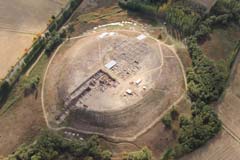- Excavation and General Survey >
- Kaman-Kalehöyük
Kaman-Kalehöyük
Sachihiro Omura Director, JIAA
About the site

Kaman-Kalehöyük (2008)
Kaman-Kalehöyük is in Çağırkan village, Kaman, Kırşehir province, Republic of Turkey. It is situated about 100 km southeast of Ankara, the capital city of Turkey, about 3km east of the city of Kaman, and south of National Route 260. It is a medium-sized, mound site 280 m in diameter and 16 m high.
JIAA conducted preliminary research at the site in 1985, and then the excavation was started with the first spade of earth by Japan's H.I.H. Prince Takahito Mikasa as the President of MECCJ in 1986. Research investigation has been conducted continuously since then.
Four main cultural periods have been identified at the site: Ottoman Empire/Byzantine Period, Iron Age, Middle and Late Bronze Ages, and Early Bronze Age. Artifacts belonging to the Chalcolithic Period and Neolithic Period have been found, so these cultures may also have existed at the site, though no settlements from these periods have been excavated yet.
The four archaeological levels are named as follows:
- Stratum I: Ottoman Empire Period (15th ~ 17th c. A.D.)
- Stratum II: Iron Age (12th ~ 4th c. B.C.)
- Stratum III: Middle and Late Bronze Ages (20th ~ 12th c. B.C.)
- Stratum IV: Last half of the Early Bronze Age (3rd millennium B.C.)
One of the objectives of Kaman-Kalehöyük excavation research is to construct a cultural chronology of the site. The research has led to some new ideas about the ancient history of Anatolia. For example, the period after the collapse of the Hittite Empire, from the 12th to 8th centuries B.C., in the Iron Age, has been called the "Dark Age" as it was considered to be without any significant culture. However, excavation of Kaman-Kalehöyük Stratum IId, belonging to the early part of that "Dark Age " period, has revealed a series of occupied levels and material culture. In the levels belonging to the 2nd millennium B.C., a succession of cultural levels can be clearly seen, from the Assyrian Colony Period, Old Hittite Kindom, and Hittite Empire Period. Artifacts that raise new opinions about when the Iron Age began are excavated one after the other.